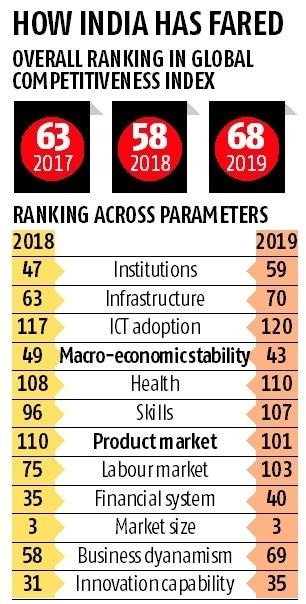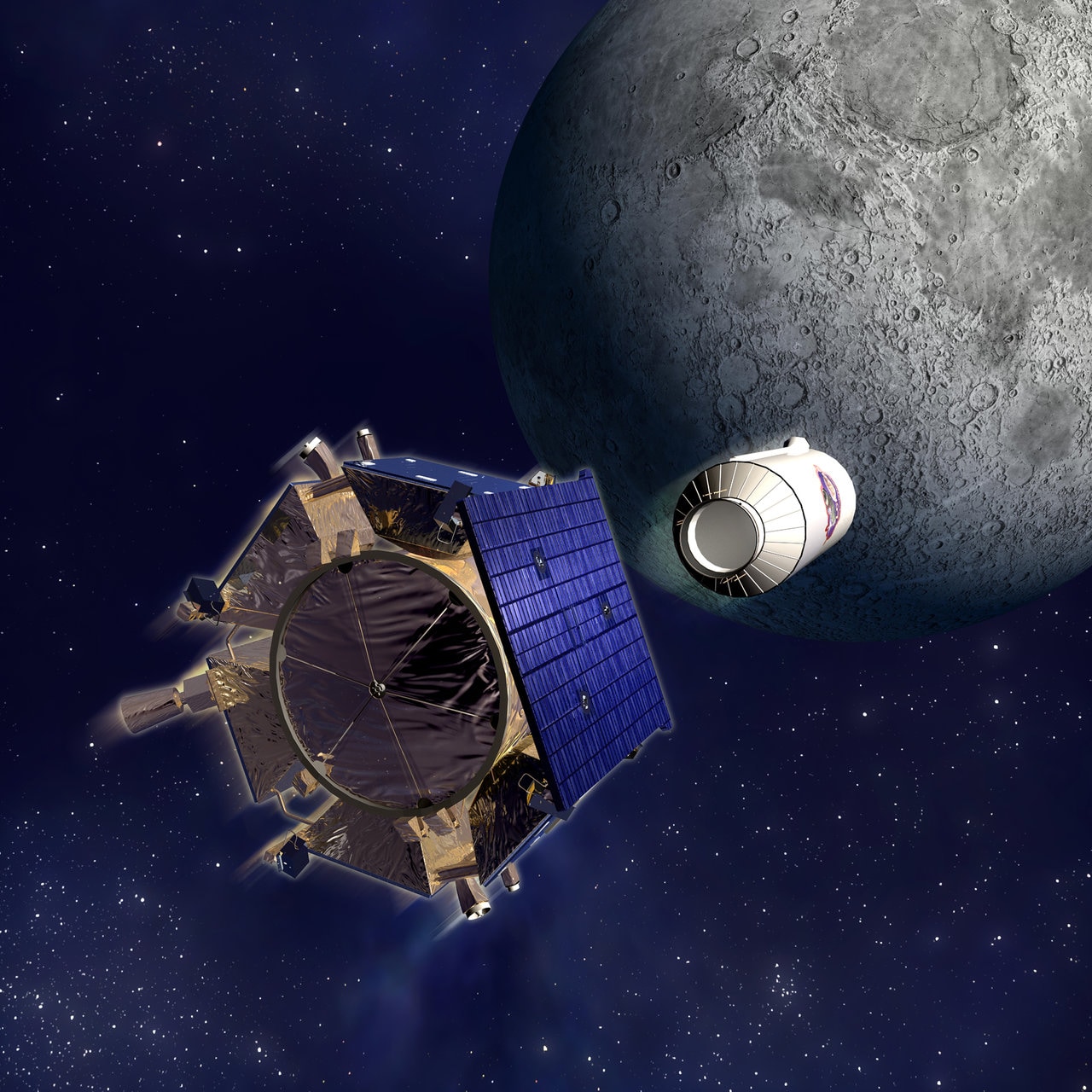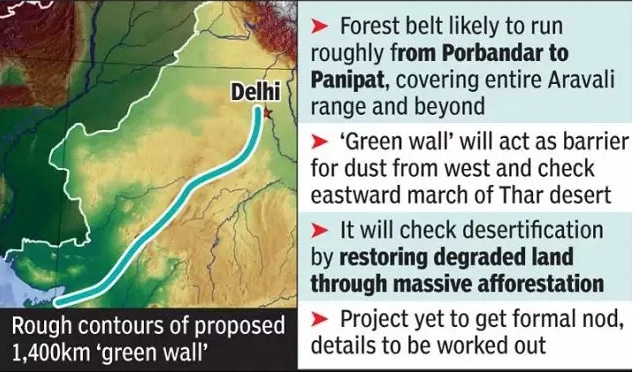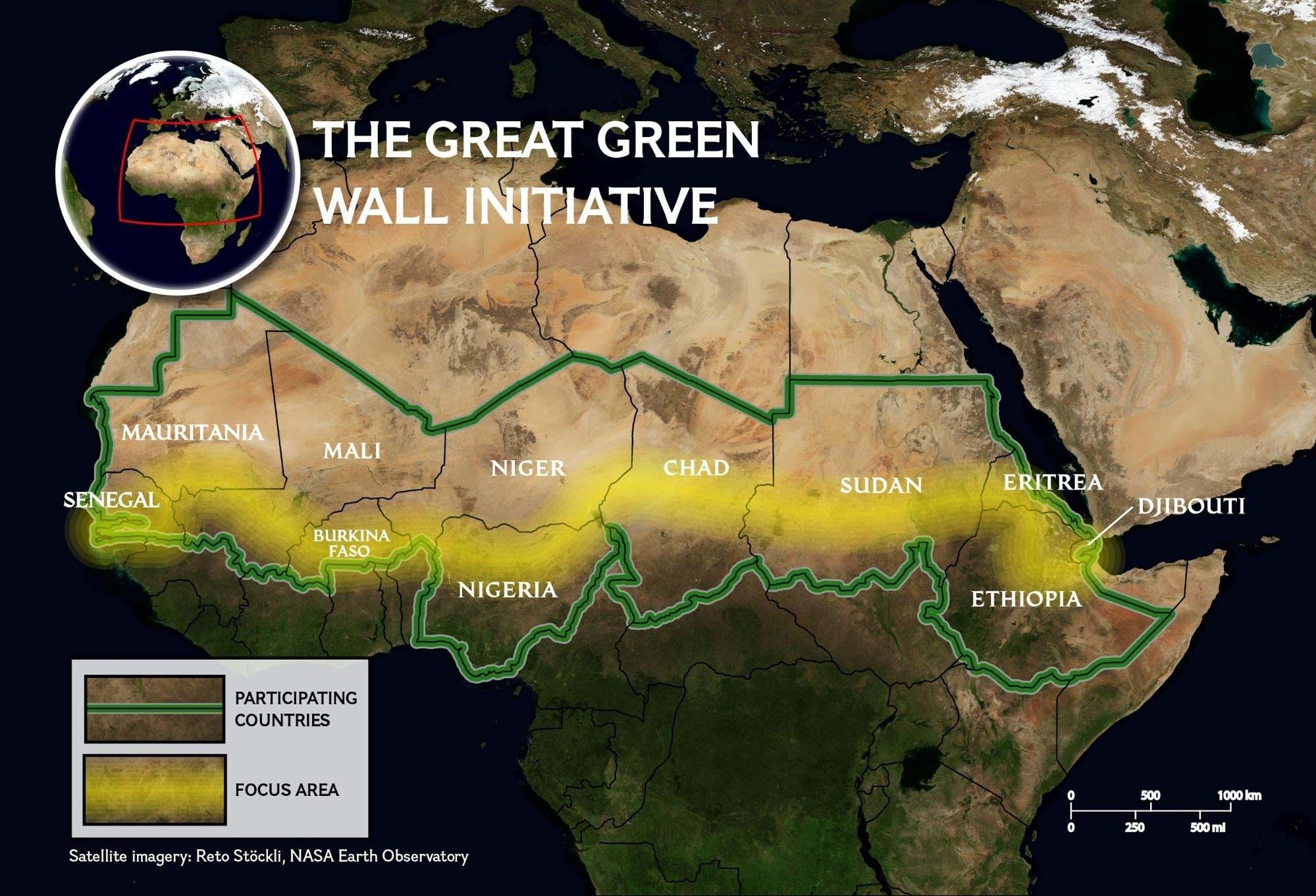Biodiversity & Environment
Green Wall of India
The Centre is mulling an ambitious plan to create a 1,400km long and 5km wide green belt from Gujarat to the Delhi-Haryana border.
- The plan is inspired by Africa’s ‘Great Green Wall’ project, running from Senegal (West) to Djibouti (East), which came into effect in 2007.
- The overarching objective of India’s Green Wall will be to address the rising rates of land degradation and the eastward expansion of the Thar desert.
- The green belt being planned from Porbandar to Panipat will help in restoring degraded land through afforestation along the Aravali hill range. It will also act as a barrier for dust coming from the deserts in western India and Pakistan.
- The Aravali has been identified as one of the key degraded zones to be taken up for greening under India’s target to restore 26 million hectares (mha) of its land.
- A 2016 report from the Indian Space Research Organisation (ISRO) had also indicated that Delhi, Gujarat and Rajasthan had already degraded over 50% of their land.
Great Green Wall of Africa
- It aims to restore Africa’s degraded landscapes and transform millions of lives in one of the world’s poorest regions, the Sahel.
- The African initiative is still only 15% complete.
- Once fully completed, the Wall will be the largest living structure on the planet – an 8,000 km natural wonder of the world stretching across the entire width of the continent.
- African countries during the UNCCCD COP14 sought global support in terms of finance to make the Wall a reality in the continent’s Sahel region by 2030.
- Sahel is a semiarid region of western and north-central Africa extending from Senegal eastward to Sudan.
- It forms a transitional zone between the arid Sahara (desert) to the north and the belt of humid savannas to the south.
Aravali Mountain Range
- The Aravallis, is the oldest fold mountains on Earth. Geological studies show its age as three billion years.
- It spans over 800km from Gujarat to Delhi (through Rajasthan and Haryana).
- The highest peak in the Aravalli Range is Guru Peak on Mount Abu.
- Influences Climate:
- The Aravallis have an impact upon the climate of northwest India and beyond.
- During monsoons, the mountain range gently guides the monsoon clouds eastwards towards Shimla and Nainital, thus helping nurture the sub-Himalayan rivers and feeding the north Indian plains.
- In the winter months, it protects the fertile alluvial river valleys (the para-Indus and Gangetic) from the assault of cold westerly winds from Central Asia.
- Concerns:
- The Aravalli range, which separates western India’s Thar desert from the relatively green plains to its east, has lost so much green cover that it is losing its ability to act as a natural barrier against the heat and dust that blows in from the west.
- The Thar desert’s expansion could threaten the “granary of India"—the fertile belts of Punjab, Haryana, western Uttar Pradesh and the Malwa region.
- Unauthorized mining for minerals and building materials has vanished some hills in the region.
- The Aravalli range, which separates western India’s Thar desert from the relatively green plains to its east, has lost so much green cover that it is losing its ability to act as a natural barrier against the heat and dust that blows in from the west.
Thar Desert
- The Thar Desert also called the Great Indian desert lies towards the western margins of the Aravali Hills.
- It is an undulating sandy plain covered with sand dunes (mainly Barchans).
- Barchans are crescent-shaped sand dune always facing the wind. It is formed when a lot of sand is present in the desert. A steady wind from one direction is also needed.
- The region receives very low rainfall below 150 mm per year.
- It has an arid climate with low vegetation cover.
- Luni is the only large river in this region.
Governance
WHO India Country Cooperation Strategy 2019–2023
Union Minister for Health & Family Welfare has launched ‘the World Health Organisation (WHO) India Country Cooperation Strategy 2019–2023: A Time of Transition’.
- The Country Cooperation Strategy (CCS) is a medium-term vision for WHO’s cooperation with a given Member State.
- The CCS provides a strategic roadmap for the WHO to work with India towards achieving its health sector goals.
- The four areas for strategic cooperation of WHO with India include:
- Universal Health Coverage (UHC).
- Health and wellness by addressing the determinants of health.
- Protection against health emergencies.
- India’s global leadership in health.
- The India CCS fully aligns itself with WHO 'triple billion' targets, the Sustainable Development Goals (SDGs) and WHO South-East Asia Region’s eight Flagship Priorities.
- It urges to address emerging health scenario of the country like non-communicable diseases, antimicrobial resistance, and air pollution, etc.
- The India CCS also connects with India’s National Health Policy 2017, and other initiatives like Ayushman Bharat, National Viral Hepatitis programme, Eat Right India movement, the Fit India movement and Poshan Abhiyaan that have collectively engaged with the people and enhanced the awareness about crucial health areas.
WHO 'Triple Billion' targets
- It is a strategic plan for the next five years.
- It aims for
- One billion more people to be benefitted from Universal Health Coverage (UHC)
- One billion more people to be protected from health emergencies
- One billion more people to be covered for better health and well-being.
National Health Policy, 2017
- It aims to achieve universal access to good quality health care services without anyone having to face financial hardship as a consequence.
- It intends to gradually increase public health expenditure to 2.5% of the GDP.
- It proposes free drugs, free diagnostics, and free emergency and essential healthcare services in public hospitals.
- The policy advocates allocating two-thirds of resources to primary care.
Science & Technology
GEMINI Device
The Union Minister of Earth Sciences has recently launched the Gagan Enabled Mariner’s Instrument for Navigation and Information (GEMINI) device.
- The device is developed for effective dissemination of emergency information and communication on Ocean States Forecast and mapping of Potential Fishing Zones (PFZ) to fishermen.
- Ocean States Forecast provides the accurate state of the ocean that includes the forecasts related to winds, waves, ocean currents, water temperature, etc.
- PFZ provide information about the probable locations of fish aggregation in the seas to the fishermen, while
- GEMINI is a portable receiver that is linked to ISRO-satellites. With this device, the fishermen outside the signal range of their phone companies (i.e. 10-12 km) can also access warnings and alerts, as the device can send signals up to 300 nautical miles.
- It will facilitate satellite-based communication that will be highly useful while dealing with cyclones, high waves, and tsunamis.
- Indian National Centre for Ocean Information Services (INCOIS) in collaboration with the Airports Authority of India (AAI) utilized the GAGAN (GPS Aided Geo Augmented Navigation) satellite while developing the GEMINI device.
- GAGAN was developed by the Indian Space Research Organization (ISRO) and the Airports Authority of India. It is India's first satellite-based global positioning system that relies on ISRO’s GSAT satellites.
- The drawback of this device is that it only allows one-way communication, i.e, it can’t be used by fishermen to make calls.
- Also, it is relatively expensive for the average fisherman (priced at ₹9,000 per device). The attempts are being made to subsidize it by as much as 90%.
Indian National Centre for Ocean Information Services (INCOIS)
- INCOIS is an autonomous organization under the Ministry of Earth Sciences (MoES).
- It is located in Hyderabad & was established in 1999 under the MoES and is a unit of the Earth System Science Organization (ESSO).
- It is mandated to provide the best possible ocean information and advisory services to society, industry, government agencies and the scientific community through sustained ocean observations and constant improvement through systematic and focused research.
Economy
Global Competitiveness Index 4.0: WEF
The World Economic Forum (WEF) has released the 2019 edition of the Global Competitiveness Report which features the Global Competitiveness Index 4.0 (GCI 4.0).
- The World Economic Forum introduced the new Global Competitiveness Index 4.0 in 2018. GCI 4.0 provides a detailed map of the factors and attributes that drive productivity, growth and human development in the era of the Fourth Industrial Revolution.
- The GCI 4.0 covers 141 economies, which account for 99% of the world’s GDP.
- The GCI 4.0 of 2019 reveal that, on average, most economies continue to be far from the competitiveness “frontier”—the aggregate ideal across all factors of competitiveness.
- A country’s performance on the overall GCI is reported as a ‘progress score’ on a 0-to-100 scale, where 100 represents the ‘frontier’, an ideal state where an issue ceases to be a constraint to productivity growth.
- This edition of the report focuses on building shared prosperity (addressing inequality) and managing the transition to a sustainable economy (addressing environmental issues) along with competitiveness and growth.
- The report is based on 12 set of factors (pillars) that determine productivity. These are: Institutions; Infrastructure; ICT adoption; Macroeconomic stability; Health; Skills; Product market; Labour market; Financial system; Market size; Business dynamism; and Innovation capability.
- The index has been an annual edition since 1979.
Key Findings
- India has moved down 10 places to the rank of 68th compared to the 58th rank of 2018 primarily because of faster improvements of several countries previously ranked lower.
- Positives for India:
- India ranks high on macroeconomic stability (90, 43rd) and market size (93.7, 3rd),
- India performs well when it comes to innovation (50.9, 35th), well ahead of most emerging economies and on par with several advanced economies.
- Its financial sector (69.5, 40th) is relatively deep and stable.
- Challenges for India:
- India ranks beyond 100th on five pillars and features in the top 50 of just four pillars.
- Major shortcomings in some of the basic enablers of competitiveness, like ICT adoption is limited (31.1, 120th) but has improved sharply (+8 since the 2017 edition).
- Health conditions remain poor, as reflected in low healthy life expectancy (59.4 years, 109th), which is one of the shortest outside Africa and significantly below the South Asian average.
- Weak banking system (60.4, 89th).
- India must also grow its skills base (50.5, 107th).
- Product market efficiency (50.4, 101st) is undermined by a lack of trade openness (43.9, 131st).
- The labour market is characterized by a lack of worker rights’ protections, insufficiently developed active labour market policies and critically low participation of women (ratio of female workers to male workers of 0.26, 128th)
- In South Asia, Sri Lanka is the most improved country in the region at 84th, Bangladesh (105th), Nepal (108th) and Pakistan (110th).
- China (28th) is the best performer among the BRICS countries.
- The Russian Federation ranks 43rd, South Africa is 60th, India is 68th and Brazil is ranked 71st.
- Singapore has become the world's most competitive economy in 2019, pushing the US to second place.
- Hong Kong Special Administrative Region (SAR) is ranked 3rd, the Netherlands is 4th and Switzerland is ranked 5th in the index.
- Vietnam (67th) registered the highest improvement across the globe.
Important Facts For Prelims
World Mental Health Day
- The Department of Empowerment of Persons with Disabilities (DEPwD) under the Ministry of Social Justice & Empowerment observed the ‘World Mental Health Day’ on 10th October 2019.
- The theme of World Mental Health Day-2019 is ‘Mental Health Promotion and Suicide Prevention’.
- According to the World Health Organization, more than 800,000 people die by suicide every year, making it the principal cause of death among people in the age group of fifteen to twenty-nine years old.
- According to the National Mental Health Survey of India, 2016, the prevalence of mental disorders was 7.3% among 13-17 years old.
- Suicide is a global public health problem that demands focused attention from all the actors related to the field of mental health, including scientific and professional organizations, organizations for mental health users, universities, national health authorities, media, etc.
- The underlying idea behind observing this day is to establish and form relevant strategies that can prevent suicide and promote the public’s mental health, as suicide is preventable and therefore, can be avoided.
- On this occasion, the Department (DEPwD) has prepared a series of activities that will be undertaken during the week by its various national institutes to raise awareness about mental health issues including identification of early signs to prevent aggravation and then start the rehabilitation/mainstreaming of successfully cured mentally ill persons.
- World Mental Health Day is organized by the World Federation for Mental Health (an international membership organization that was founded in 1948 with the aim to promote the advancement of mental health awareness & prevention of mental disorders).
Important Facts For Prelims
Malware Smominru
Malware Smominru, whose incidence was first reported in 2017, continues to infect computers in a big way.
- It is affecting nearly 4,700 computers every day, with over 90,000 computers affected globally in August 2019.
- The botnet relies on more than 20 dedicated servers, mostly located in the US, though some are hosted in Malaysia and Bulgaria.
- In its post-infection phase, it steals victim credentials, installs a Trojan module and a cryptominer and propagates inside the network.
- The malware seems to have the ability to come back to hit the old victims if they fail to tackle the problem completely. About one-fourth of the affected machines were infected again after Smominru was removed from them.
- The victims range from universities to healthcare providers suggesting that hackers are not too particular about their targets.
- However, about 85% of infections have occurred on Windows 7 and Windows Server 2008 systems.
- The objective seems to silently use infected computers for mining cryptocurrency at the victim’s expense.
- China, Taiwan, Russia, Brazil and the US have seen the most attacks.
Note
- Malware: Short for malicious software, it refers to any kind of software that is designed to cause damage to a single computer, server, or computer network. Ransomware, Spy ware, Worms, viruses, and Trojans are all varieties of malware.
- Botnet: The word Botnet is formed from the words ‘robot’ and ‘network’. It is a network of infected computers that can be controlled remotely, forcing them to send spam, spread viruses, or stage Distributed Denial of Service (DDoS) attacks without the consent of the computer's’ owners.
Important Facts For Prelims
Exercise Ekuverin
The tenth edition of the Joint Military Exercise Ekuverin, between the Indian Army and the Maldives National Defence Force, is being held from 7th-20th October, 2019 in Pune, Maharashtra.
- India and Maldives have been conducting Exercise Ekuverin meaning ‘Friends’ in the Maldivian language since 2009.
- The 14 days Joint Exercise is held alternatively in India and Maldives.
- It focuses on enhancing interoperability between the two forces for carrying out counter insurgency and counter-terrorism operations in a semi-urban environment under the United Nations mandate.
- The ninth edition of the exercise was held in 2018 in Maldives.
Important Facts For Prelims
LCROSS: NASA
A decade after National Aeronautics and Space Administration (NASA) sent a Lunar CRater Observations and Sensing Satellite (LCROSS) to the moon's south pole, the space agency is about to start the same project again.
to the moon's south pole, the space agency is about to start the same project again.
- LCROSS was launched with the Lunar Reconnaissance Orbiter (LRO) in 2009.
- It aimed to determine if water-ice exists in a permanently shadowed crater at the Moon's south pole.
- LCROSS and LRO found evidence of the lunar soil in shadowy craters.
- It also revealed that the Moon is chemically active and has a water cycle.
- LCROSS also confirmed the water was in the form of mostly pure ice crystals in some places.
Important Facts For Prelims
Pradhan Mantri Innovative Learning Programme- DHRUV
Recently, the Union Human Resource Development Minister has launched the Pradhan Mantri Innovative Learning Programme named ‘DHRUV’.
- The objective of the Pradhan Mantri Innovative Learning Programme is to encourage talented students to realize their full potential and henceforth, contribute to society.
- The programme is named DHRUV after the Pole Star with the same name. Every student selected under this programme will be called as ‘Dhruv Tara’. The students will thus both shine through their achievements and light a path for others to follow.
- The programme will cover two areas namely, Science and Performing Arts.
- Overall 60 students will be selected (30 from each area) from across the country.
- The students will be broadly from classes 9 to 12 from all schools including government and private.






